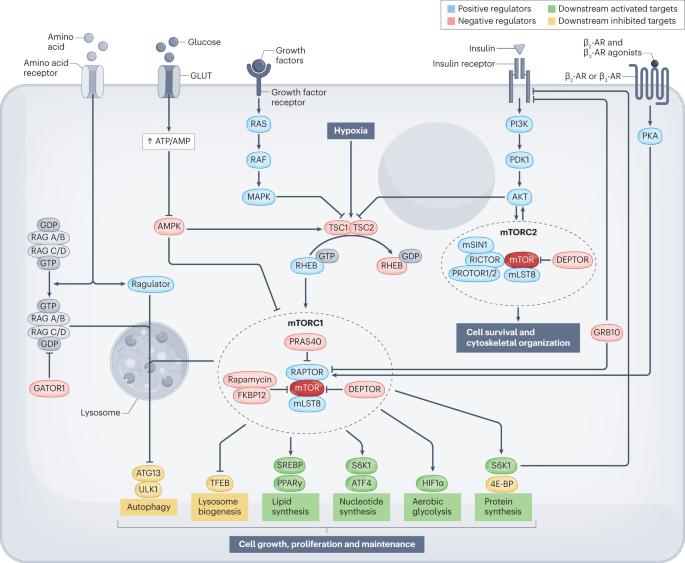mTORC1 in energy expenditure: consequences for obesity
IF 31
1区 医学
Q1 ENDOCRINOLOGY & METABOLISM
引用次数: 0
Abstract
In eukaryotic cells, the mammalian target of rapamycin complex 1 (sometimes referred to as the mechanistic target of rapamycin complex 1; mTORC1) orchestrates cellular metabolism in response to environmental energy availability. As a result, at the organismal level, mTORC1 signalling regulates the intake, storage and use of energy by acting as a hub for the actions of nutrients and hormones, such as leptin and insulin, in different cell types. It is therefore unsurprising that deregulated mTORC1 signalling is associated with obesity. Strategies that increase energy expenditure offer therapeutic promise for the treatment of obesity. Here we review current evidence illustrating the critical role of mTORC1 signalling in the regulation of energy expenditure and adaptive thermogenesis through its various effects in neuronal circuits, adipose tissue and skeletal muscle. Understanding how mTORC1 signalling in one organ and cell type affects responses in other organs and cell types could be key to developing better, safer treatments targeting this pathway in obesity. The protein complex mTORC1 is a key regulator of cellular metabolism in response to energy availability. This Review discusses the role of mTORC1 in regulating energy expenditure and the implications for the development and treatment of obesity.


能量消耗中的 mTORC1:对肥胖症的影响
在真核细胞中,哺乳动物雷帕霉素靶点复合体 1(有时也称为雷帕霉素机械靶点复合体 1;mTORC1)根据环境能量的可用性协调细胞的新陈代谢。因此,在生物体水平上,mTORC1 信号通过充当不同类型细胞中营养素和激素(如瘦素和胰岛素)作用的枢纽,调节能量的摄入、储存和使用。因此,mTORC1 信号的失调与肥胖有关也就不足为奇了。增加能量消耗的策略为治疗肥胖症带来了希望。在此,我们回顾了目前的证据,这些证据说明了 mTORC1 信号通过其在神经元回路、脂肪组织和骨骼肌中的各种作用,在调节能量消耗和适应性产热中发挥着关键作用。了解一个器官和细胞类型中的 mTORC1 信号如何影响其他器官和细胞类型的反应,可能是针对这一途径开发更好、更安全的肥胖症治疗方法的关键。
本文章由计算机程序翻译,如有差异,请以英文原文为准。
求助全文
约1分钟内获得全文
求助全文
来源期刊

Nature Reviews Endocrinology
医学-内分泌学与代谢
CiteScore
42.00
自引率
0.70%
发文量
158
审稿时长
6-12 weeks
期刊介绍:
Nature Reviews Endocrinology aspires to be the foremost platform for reviews and commentaries catering to the scientific communities it serves. The journal aims to publish articles characterized by authority, accessibility, and clarity, enhanced with easily understandable figures, tables, and other visual aids. The goal is to offer an unparalleled service to authors, referees, and readers, striving to maximize the usefulness and impact of each article. Nature Reviews Endocrinology publishes Research Highlights, Comments, News & Views, Reviews, Consensus Statements, and Perspectives relevant to researchers and clinicians in the fields of endocrinology and metabolism. Its broad scope ensures that the work it publishes reaches the widest possible audience.
 求助内容:
求助内容: 应助结果提醒方式:
应助结果提醒方式:


